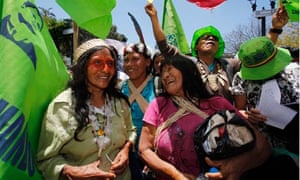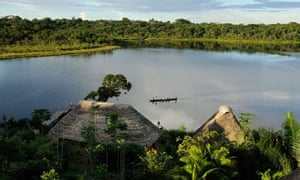Why Ecuador's president is misleading the world on Yasuni- ...Think China
Rafael Correa has moved to abolish an historic Amazon oil plan, but don't be fooled by what he claims



The Ishpingo-Tambococha-Tiputini region of Yasuni contains more species in a hectare than all the wildlife in North America. Photograph:
The decision by Ecuador's president Rafael Correa to abandon a plan to permanently forgo exploiting hundreds of millions of barrels of oil in return for at least US$3.6bn in compensation – the "Yasuni-ITT Initiative" – has sparked severe non-state media criticism in Ecuador, calls for a referendum, protests in numerous cities and embassies around the world, and an international outcry.
Here are just four ways in which Correa's attempt to explain his decision are misleading:
1. In the TV speech on 15 August when he announced his decision Correa said that the oil exploitation he is now promoting will affect less than 1% of the Yasuni national park, a 1,030,070 hectare area, according to him, in Ecuador's Amazon.
'The choice was: Yasuni 100% intact and have no money to fight poverty or 99% of Yasuni intact – at least 99% – and have about US$18 billion,' he said, emphasizing that the decree liquidating the Yasuni-ITT Initiative prohibits more than 1% of the park being affected and then later that day tweeting he had made an 'error' and only 0.1% of the park would be affected.
What were these figures based on? Possibly an 'impact study' of a plan to drill 32 wells in the Tiputini and Tambococha fields which was written by PetroAmazonas, part of state oil company PetroEcuador, and estimates that 16.8 hectares and therefore only '0.0017%' of the park will be directly impacted, or Ministry of Non-Renewable Natural Resources (MNRNR) data arguing that exploitation of all three Tiputini, Tambococha and Ishpingo fields will directly impact 'about 200 hectares' – '0.02%.'
Whatever the case, Correa ignored the fact that this '0.0017%' estimate appears to exclude planned 3D seismic tests in the Tambococha field, and that 'Block ITT' or 'Block 43', as the concession is called, extends for over 100,000 hectares of Yasuni and therefore operations could expand much, much deeper into the park.
Most significantly of all, Correa ignored the much wider context. Although he made passing reference to 'four existing oil exploitation projects' in Yasuni, he didn't mention that, according to the Ministry of Environment, six oil concessions in addition to Block ITT include parts of Yasuni and therefore over 350,000 hectares of the park is already overlapped.
2. In the same TV speech Correa said that exploitation in Yasuni will be done with 'cutting-edge techniques', a claim that appears to be supported by PetroAmazonas´s 'impact study' which states that Tiputini and Tambococha 'will be developed using best practices.'
Indeed, PetroAmazonas specifically states that no roads will be built to exploit those two fields. Some experts on oil industry best practices consider roads in fragile environments like the Amazon a strict no-no, and the International Association of Oil and Gas Producers called them years ago the 'greatest single cause of environmental impact' in the rainforest.
But is the ban on roads for real?
In neighbouring Block 31 – which overlaps 173,857 hectares of Yasuni – a Petrobras 'Environmental Management Plan' from 2006 stated that 'no new access roads will be built', only a 5.1 km 'sendero' ('path', 'track', 'trail') made of 'geoblocks' linking two drilling platforms.
However, in 2009 PetroAmazonas took over Block 31 and in 2012 built a 19km road right into the heart of it. This is one of the four projects briefly mentioned by Correa in his 15 August TV speech, all of which he described as 'examples of environmentally friendly exploitation.'
Says Matt Finer, a scientist at the Center for International Environmental Law and co-author of a ground-breaking article published earlier this year on oil industry best practices in the Amazon:
The available evidence indicates that Ecuador indeed plans to build new access roads deep into the core of the park to reach a number of extremely isolated oil fields. In testimony before a Congressional commission last month the Minister for Non-Renewable Natural Resources said they won't build 'access roads' deeper in Blocks 43 and 31, but both he and the head of PetroAmazonas said they will build 'ecological trails.' Now that might sound good, but in an earlier document submitted to Congress, the Ministry describes the access route recently built in Block 31 as an 'ecological trail' as well. However, thanks to a National Geographic article published in January, we know that that's really just an access road with a greener name.
3. During his 15 August TV speech Correa emphasized how many poor Ecuadorians should benefit from ITT exploitation, but made absolutely no mention of those who might be seriously harmed by it.
Top of the list are the indigenous people living in 'isolation' (IPI) in Yasuni, who ultimately stand to lose parts of their territory and could be decimated by any form of contact with oil company workers because of their lack of immunological defences.
The assumption in that speech was that no such people exist – an assumption suddenly, and absurdly, turned into Correa administration policy. A Ministry of Justice report sent to the National Assembly in September states there are no IPI in this region, and includes a map with three ovals marking the presence of such people to the west, south-west and south of Block 43, but not overlapping Block 43 itself.
'No records exist regarding the presence of indigenous peoples in isolation in Blocks 31 and 43,' it claims.
However, what that report and map ignores is the many people and institutions who have acknowledged the presence of IPI: anthropologists, NGOs, and, as their own professed past support for the Yasuni-ITT initiative makes explicit, even Correa himself, his government and the UN, which administered one of two trust funds collecting donations.
'Two and a half months ago what was Correa saying? That one of the main two reasons to keep up with this initiative was to protect the non-contacted tribes in the park,' says Ecuadorian journalist and filmmaker Carlos Andres Vera.
Indeed, the government has made this sudden u-turn despite the existence of a supposedly 'intangible zone' for the IPI which includes the southern quarter of Block ITT and had its boundaries defined by an Executive Decree published on Correa's very first full day in office. Moreover, that 'intangible zone' was described as a form of 'minimum' protection for the IPI – because it wasn't clear how far their territories extended – by a 'National Policy on Peoples in Voluntary Isolation' adopted by Correa just three months later.
In addition, the government u-turn and Ministry of Justice map fly in the face of a map sent by the Ministry of Environment to the Inter-American Commission on Human Rights in April this year that was marked with fourovals – one overlapping the southern part of Block 43. As one Ecuadorian website asked sarcastically:
What extraordinary events happened in just four months, between 22 April and 21 August, for the location of the uncontacted groups to have changed so radically and for [the Justice] Minister, with his new map, to make them mysteriously disappear from all the oil concessions? The only extraordinary thing is president Rafael Correa's Decree no.74, signed on 15 August which buried the Yasuni-ITT initiative and permitted oil exploitation in Blocks 31 and 43 in the Yasuni National Park.
4. Why does the Yasuni-ITT Initiative appear to have failed, for now at least? Correa, on 15 August, admitted he had made mistakes, but also claimed 'we did what we could' and laid most of the blame elsewhere.
'The world failed us,' he said.
No doubt, the fact that only US$13.3 million, according to Correa, was donated to the two trust funds constitutes a pathetic and in some ways scandalous international response. Add to that the global economic crisis and Ecuador's default on sovereign debt in 2008-2009 which discouraged lenders and made it increasingly dependent for finance on China, which will be paid back in oil and whose companies have been directly linked to ITT exploitation.
But what about Correa's own handling of the initiative, and how serious was he or could he be - running a comparatively poor country dependent on oil - about not drilling?
Critics say he discouraged potential financial contributors by confused aims and strategies, publicly attacking the UN and his own negotiating team, and refusing to abandon a 'Plan B' to exploit ITT and making increasingly frequent references to it.
In addition, activities in adjacent concessions always aroused suspicion. In 2011 Block 14, *operated by PetroOriental, owned by Chinese state company SINOPEC, was mysteriously extended east to Block ITT, creating an 'oil corridor', according to NGO Accion Ecologica, and meaning that PetroOriental was now 'just one step from Tiputini.'
The following year the so-called 'ecological trail' was built into Block 31 where the deposits are so small in comparison to ITT that critics say the 'real reason', according to the National Geographic in January, is to 'lay the infrastructure for an eventual move into the ITT Block next door.'
No wonder many potential donors were never convinced.
No comments:
Post a Comment
Comments always welcome!